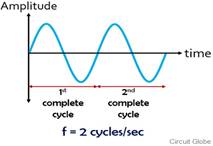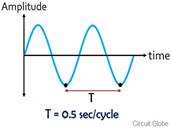
Concept explainers
The difference between frequency and time period.
Answer to Problem 37A
Frequency is the number of completed cycles per unit time where as the time period is the time taken to complete one cycle. When the object comes back from the extreme position to its initial position the cycle is counted to be one. The time taken to complete one such cycle is called time period and number of such cycles completed in per unit time is called frequency.
Explanation of Solution
Introduction:
Frequency is the number of cycles performed in given unit time. The unit of frequency is Hertz and denoted by
Period is the reciprocal of the frequency. It is the time taken to complete one complete cycle. It is given by
Frequency is the number of all the complete waves which occur repeatedly in a unit time.
Frequency is denoted by

Period is defined as the duration of time which is required by a wave to complete a unit cycle.
It is denoted by

Conclusion:
Hence,frequency is the number of all the cycles of a wave which occurs in a given specific time. Time period is the time duration in which one complete cycle of wave is achieved.
Chapter 14 Solutions
Glencoe Physics: Principles and Problems, Student Edition
Additional Science Textbook Solutions
Organic Chemistry (8th Edition)
Campbell Biology: Concepts & Connections (9th Edition)
Chemistry: Structure and Properties (2nd Edition)
Campbell Essential Biology (7th Edition)
Chemistry & Chemical Reactivity
Genetic Analysis: An Integrated Approach (3rd Edition)
- Consider a rubber rod that has been rubbed with fur to give the rod a net negative charge, and a glass rod that has been rubbed with silk to give it a net positive charge. After being charged by contact by the fur and silk...? a. Both rods have less mass b. the rubber rod has more mass and the glass rod has less mass c. both rods have more mass d. the masses of both rods are unchanged e. the rubber rod has less mass and the glass rod has mroe massarrow_forward8) 9)arrow_forward10) 11) 12) 13) 14) 15)arrow_forward
- Mick and Rick are twins born on Earth in the year 2175. Rick grows up to be an Earth-bound robotics technician while Mick becomes an intergalactic astronaut. Mick leaves the Earth on his first space mission in the year 2200 and travels, according to his clock, for 10 years at a speed of 0.75c. Unfortunately, at this point in his journey, the structure of his ship undergoes mechanical breakdown and the ship explodes. How old is Rick when his brother dies?arrow_forwardHi, I have canceled, why did you charge me again?arrow_forwardNo chatgpt pls will upvotearrow_forward
 College PhysicsPhysicsISBN:9781305952300Author:Raymond A. Serway, Chris VuillePublisher:Cengage Learning
College PhysicsPhysicsISBN:9781305952300Author:Raymond A. Serway, Chris VuillePublisher:Cengage Learning University Physics (14th Edition)PhysicsISBN:9780133969290Author:Hugh D. Young, Roger A. FreedmanPublisher:PEARSON
University Physics (14th Edition)PhysicsISBN:9780133969290Author:Hugh D. Young, Roger A. FreedmanPublisher:PEARSON Introduction To Quantum MechanicsPhysicsISBN:9781107189638Author:Griffiths, David J., Schroeter, Darrell F.Publisher:Cambridge University Press
Introduction To Quantum MechanicsPhysicsISBN:9781107189638Author:Griffiths, David J., Schroeter, Darrell F.Publisher:Cambridge University Press Physics for Scientists and EngineersPhysicsISBN:9781337553278Author:Raymond A. Serway, John W. JewettPublisher:Cengage Learning
Physics for Scientists and EngineersPhysicsISBN:9781337553278Author:Raymond A. Serway, John W. JewettPublisher:Cengage Learning Lecture- Tutorials for Introductory AstronomyPhysicsISBN:9780321820464Author:Edward E. Prather, Tim P. Slater, Jeff P. Adams, Gina BrissendenPublisher:Addison-Wesley
Lecture- Tutorials for Introductory AstronomyPhysicsISBN:9780321820464Author:Edward E. Prather, Tim P. Slater, Jeff P. Adams, Gina BrissendenPublisher:Addison-Wesley College Physics: A Strategic Approach (4th Editio...PhysicsISBN:9780134609034Author:Randall D. Knight (Professor Emeritus), Brian Jones, Stuart FieldPublisher:PEARSON
College Physics: A Strategic Approach (4th Editio...PhysicsISBN:9780134609034Author:Randall D. Knight (Professor Emeritus), Brian Jones, Stuart FieldPublisher:PEARSON





